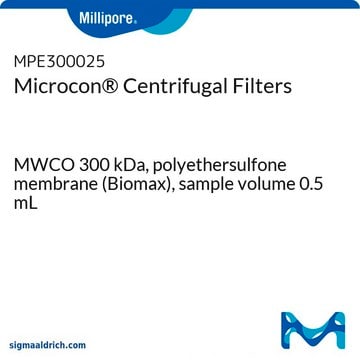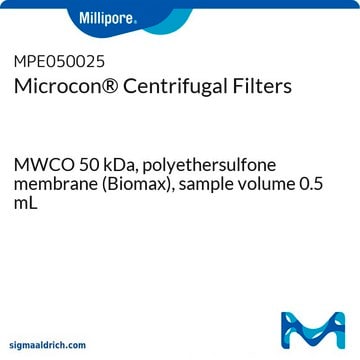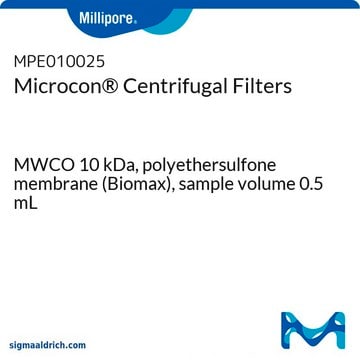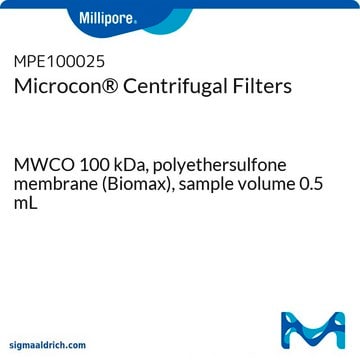Yes, a Microcon DNA fast flow device can be used to isolate DNA from a crude cell lysis preparation. However, lysates typically contain heavy particulate contamination, so clarification spins may be necessary to remove particulates before attempting ultrafiltration.
MRCF0R100
Unità filtrante per centrifuga Microcon DNA Fast Flow, con
sample volume 0.5 mL, Ultracel® regenerated cellulose membrane (low binding)
Sinonimo/i:
Centrifuge concentrator
Scegli un formato
Scegli un formato
About This Item
Prodotti consigliati
Materiali
Ultracel® regenerated cellulose membrane (low binding)
polyacetal base (membrane support)
polycarbonate device top
polypropylene tube (for filtrate/concentrate)
silicone O-ring (medical-grade)
Livello qualitativo
Sterilità
non-sterile
Caratteristiche
holdup volume> 10 μL
Confezionamento
pkg of 100 ea
Produttore/marchio commerciale
Microcon®
Parametri
0.5 mL sample volume
tecniche
DNA purification: suitable
RNA purification: suitable
Lunghezza
4.50 cm (1.8 in.)
Diametro
12.3 mm
Superficie filtrante
0.32 cm2
Volume d’esercizio
0.5 mL
Condizioni di spedizione
ambient
Categorie correlate
Descrizione generale
Applicazioni
Caratteristiche e vantaggi
- recuperi elevati anche con piccoli volumi grazie alla funzione di centrifugazione inversa
- membrana Ultracel® a basso adsorbimento
- tempo di processamento rapido
- con fattori di concentrazione <20X assicurano la massima riproducibilità
Linkage
Note legali
Certificati d'analisi (COA)
Cerca il Certificati d'analisi (COA) digitando il numero di lotto/batch corrispondente. I numeri di lotto o di batch sono stampati sull'etichetta dei prodotti dopo la parola ‘Lotto’ o ‘Batch’.
Possiedi già questo prodotto?
I documenti relativi ai prodotti acquistati recentemente sono disponibili nell’Archivio dei documenti.
Contenuto correlato
Microcon® Centrifugal Filters simply and efficiently concentrate and desalt solutions of DNA, RNA, protein or other macromolecules, using any centrifuge that can accept 1.5 mL tubes.
-
Can I use a Microcon DNA fast flow device to isolate DNA from a crude cell lysis preparation such a freeze thaw in TE buffer or a chelex 100 extraction?
1 risposta-
Utile?
-
-
The user guide indicates you can't autoclave these microcon, but can you sterilize them in a UV Crosslinker?
1 risposta-
The Microcon devices are non-sterile. These devices cannot be sterilized by UV or autoclaving. However, it is possible to sanitize the devices with 70% ethanol. Please see the protocol for sanitization below:
1. Reagent Preparation: 70% Ethanol solution (v/v) is prepared by dilution in distilled water. Both the ethanol solution and distilled water used for rinsing should be filter-sterilized using sterile, 0.22 µm sterilizing grade filter device.
2.Sanitization Protocol:
A. Fill the Microcon device to its published capacity with filter-sterilized 70% ethanol, and cap the unit (note that the collection tubes can be sanitized in the same manner).
B. Invert device by hand or in an end-over-end mixer to continuously wet all internal surfaces of the device.
C. Incubate for a minimum of 5 minutes (note that the device can be capped and left for up to 24 hours if it is not going to be used immediately).
D. Spin at recommended G-force using appropriate centrifuge until at least 50% of the volume has passed through the device.
E. Aseptically discard any remaining ethanol from the filter device and filter collection tube.
F. Immediately rinse away residual ethanol by adding the filter-sterilized water to the device's published capacity, mix gently to wet all areas, and centrifuge until at least 50% of the volume has passed through the device.
G. Discard any remaining liquid from both the concentrator device and filter collection tube before use.
DO NOT let the filter membrane dry out in concentrator unit. If the devices are not to be used immediately, fill the devices with filter-sterilized distilled water, cover, and store refrigerated. Remove liquid from device as previously described prior to use.
Utile?
-
-
Has the color of the Microcon DNA Fast Flow become brighter blue?
1 risposta-
Yes, the color of the device has changed. A new blue colorant and clear resin have replaced the original blue reservoir resin, which has been discontinued. Both old and new resin are HP2 Polycarbonate. The functionality of the product has not changed.
Utile?
-
Filtri attivi
Il team dei nostri ricercatori vanta grande esperienza in tutte le aree della ricerca quali Life Science, scienza dei materiali, sintesi chimica, cromatografia, discipline analitiche, ecc..
Contatta l'Assistenza Tecnica.






